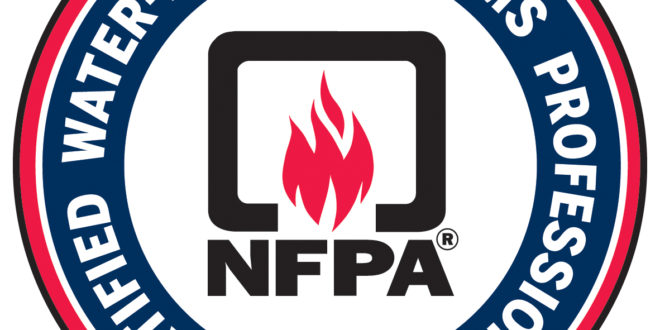NFPA’s New Certified Water-Based System Professional Certification Ensures a New Hire Has What It Takes
When you are dealing with safety and people’s lives, it’s critical to “get it right.” For companies that design fire protection systems, that means having the highest level of confidence in the people who are laying out the systems. They are ultimately the factor that will make the difference between a safe building or your company’s name being tied to a horrific incident.
So how do you know if your designers are qualified? Better yet, when you are about to hire new designers to either build your company or take on the big job you’ve just sold, how do you know that they are the right fit? How to do you know that they won’t end up costing you hundreds of hours of unexpected training time or tens of thousands dollars in resubmittals or change orders?
Ideally, these candidates will have decades of experience, amazing references, and an industry-wide reputation. In reality, we are lucky if we find one of those things in a candidate. In most cases, managers are relying on an interview, hearsay, or a piece of paper saying that the individual is qualified. But are those the types of confirmations a design manager can feel comfortable with?
Over the past several years, NFPA has been approached by major sprinkler associations, as well as other groups, organizations, and individuals to help answer those questions, and to assist in coming up with a tool that would allow employers to confirm that their new hires are as good as they needed them to be. As the years passed, this U.S.-based need developed into a global one. In seminars and conferences around the world, NFPA was continually asked how to confirm that the people being hired understood the nuances of NFPA’s sprinkler design standards. Furthermore, could NFPA provide a tool confirming that someone could access the standard and illustrate that they could execute the requirements as they would be required to for a new design job?
In response to these requests, NFPA has released the Certified Water-Based System Professional (CWBSP) Certification, a new certification that provides companies with the assurance they are looking for when hiring or promoting designers. What makes this certification unique is that it poses real-world challenges to the candidate that simulate the types of questions they would face on a design project. This is not simply a recall exam where if you can find the right section in the book, you will be able to find the answer to the question without having any knowledge of system design or hydraulics. This exam requires candidates to have insight into the practical application of the standards based on their educational experience and their experience executing the requirements of the applicable standards.
The CWBSP certification covers multiple water-based system concepts including sprinkler system layouts, fire pumps, standpipes, water supplies, residential systems and much more. This role requires candidates to have experience with and be able to execute the requirements of several NFPA standards including NFPA 13, Standard for the Installation of Sprinkler Systems; NFPA 20, Standard for the Installation of Stationary Pumps for Fire Protection; and NFPA 22, Standard for Water Tanks for Private Fire Protection; and more. The certification also addresses both new and existing systems so that companies taking on considerable tenant improvement work can rest assured that their designers know how to not only look at plans and lay out a system but can also analyze an existing system and understand what modifications need to be made for future tenant plans.
Also included are comprehensive design scenarios that require the candidate to understand the baseline code requirement and to make adjustments based on the type of sprinkler or occupancy described in the problem. These scenarios cover both occupancy-based examples and storage arrangements.
Not only are codes and standards constantly changing, but so are the hazards that designers must protect against; the CWBSP certification covers the most current topics and hazards that our industry is facing. For designers who want to prove that they have the experience and a finger on the pulse of the industry, the CWBSP certification is a must. NFPA wants to make sure that candidates for this certification are the best of the best. That’s where we started when we developed this program.
NFPA developed this new certification with the assistance of a Certification Advisory Group (CAG) consisting of members of the water-based system design community. This group included entry-level designers, seasoned veterans of the industry and everyone in between. In addition to the varied experience levels brought to the group, the CAG consisted of individuals with varying educational backgrounds, geographical locations, and areas of expertise.
In today’s economic climate, you are only as good as the last job you did. The competition for new work and TI work is fierce with new design companies popping up all over the place. Owners and design managers can’t afford to be wrong about even the smallest job if they want to continue to grow, maintain, or strengthen their reputation. If you want to make sure that a new hire has what it takes, the NFPA Certified Water-Based System Professional certification provides that assurance.
 ABOUT THE AUTHOR: Matt Klaus, PE is the director of technical services and principal fire protection engineer at the National Fire Protection Association (NFPA), where he is responsible for NFPA documents addressing commissioning, integrated system testing and automatic sprinkler systems. Klaus has extensive international fire protection engineering consulting experience where he was a project manager for projects in Dubai, Abu Dhabi, Qatar, the Kingdom of Bahrain, Kenya, and Great Britain, as well as projects across the United States. His experience includes designing and commissioning fire protection systems including smoke control systems, suppression systems, and fire alarm systems.
ABOUT THE AUTHOR: Matt Klaus, PE is the director of technical services and principal fire protection engineer at the National Fire Protection Association (NFPA), where he is responsible for NFPA documents addressing commissioning, integrated system testing and automatic sprinkler systems. Klaus has extensive international fire protection engineering consulting experience where he was a project manager for projects in Dubai, Abu Dhabi, Qatar, the Kingdom of Bahrain, Kenya, and Great Britain, as well as projects across the United States. His experience includes designing and commissioning fire protection systems including smoke control systems, suppression systems, and fire alarm systems.
 Sprinkler Age A Publication of the American Fire Sprinkler Association
Sprinkler Age A Publication of the American Fire Sprinkler Association
